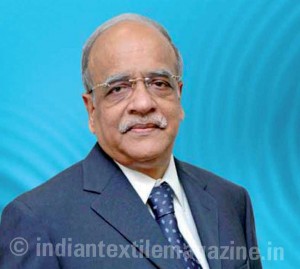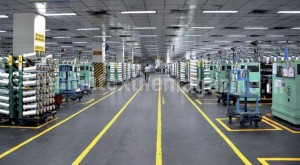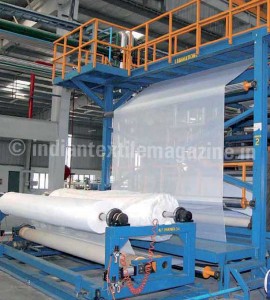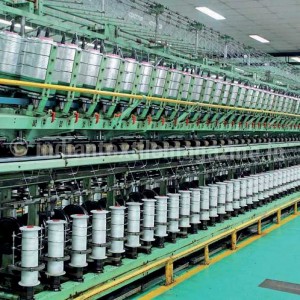
SRF, established in 1970 as Shri Ram Fibres, is a global entity with operations in four different countries. The company was initially engaged in the manufacture of chemical-based industrial intermediates. It later diversified into technical textiles, industrial yarn, refrigerants, chemicals, packaging films and engineering plastics.
Headquartered in Gurgaon, SRF has eight manufacturing plants in India and one each in the UAE, Thailand and South Africa. A market leader in most of its businesses in its home market in India, it is the world’s second largest manufacturer of both the nylon 6 tyre cord and belting fabrics. The company classifies its main businesses as technical textiles business (TTB), chemicals & polymers business (CPB) and packaging films business (PFB).
The R&D centre of SRF’s technical textile business is located at Manali in Tamil Nadu. Equipped with state-of-the-art facilities, including pilot plants and testing laboratories, it is used for development of new products and new processes in the field of technical textiles. Products from these activities have been used by a leading European manufacturer as well as for in-house consumption.
Besides, several research projects are in progress with leading Indian and overseas academic and research institutes. Due to the softening of commodity prices which led to a fall in business, the overall sales of technical textiles business has been Rs. 1,667.88 crores. The fall in prices was, however, compensated by an increase in revenues from newer business segments like laminated fabrics and new products under coated fabrics.

Technical textile business
SRF’s nylon tyre cord fabric (NTCF) business has a market share of about 40 per cent in the Indian market. The company’s NTCFs are supplied to the bus and truck tyre industry, with its future depending upon the GDP growth curve. The company’s polyester tyre cord fabrics (PTCF) business caters to the radial tyre segment of passenger cars and light commercial vehicles. The company is engaged in the process of diversifying its product portfolio at the yarn stage to move towards full utilisation of its capacity. Meanwhile, it has made initial forays into seat belts and geo-textile segments of the market, which has a promising future.
SRF is the second largest producer of belting fabrics in the world. Though the segment is a potential one, its growth depends upon the key infrastructure projects of the country, such as mining, power and construction, which has been facing a slowdown. The company’s laminated fabric business has gained a market share of over 25 per cent within a couple of years of its existence and is now the second largest player in the country. The company has set up its first hot lamination facility in the country to expand its product range and compete effectively with overseas players.

The coated fabric segment of SRF, with a market share of 40 per cent, posted a 10 per cent growth in volume and expanded its product range using the new facility at Gummidipoondi. Several new products such as pagodas, double-sided striped awnings and lacquered tarpaulins (printable) have been introduced in the market towards the end of last financial year. The new products offer possibilities of a significant growth in the coming years.
In order to achieve maximum capacity utilization, the company has also initiated exports to the Middle East and South-East Asian countries. It continues to be the supplier of choice in many of the industrial yarn segments of nylon and polyester for conveyor belts, transmission belts, ropes, geo-textiles, fishnets, etc.
With the slowdown in the infrastructure development in the country, it is expected that radialisation in the bus and truck segment would be adversely affected. This is likely to benefit the NTCF segment of TTB since the demand for bias tyres is expected to remain the same or increase marginally (bias tyres are better suited for bad roads as compared to radial tyres).
The net sales of SRF declined by 5.69 per cent from Rs. 3,512.73 crores in 2011-12 to Rs. 3,312.77 crores in 2012-13. Its profit before tax was down by 37.69 per cent, from Rs. 565.86 crores to Rs. 352.59 crores and profit after tax decreased by 33.26 per cent from Rs. 387.38 crores in 2011-12 to Rs. 258.51 crores in 2012-13.

Impressive performance
The company has reported 100 per cent growth in net PAT at Rs. 44 crores during the first quarter of 2013-14 against Rs. 22 crores reported during the corresponding period last year. The company’s net sales during April-June of 2013 marginally improved to Rs. 819 crores from Rs. 810 crores. Profit before tax improved by 70 per cent, from Rs. 30 crores to Rs. 51 crores during April-June 2013.
Reflecting on the financial performance of the company, Mr. Ashish Bharat Ram, Managing Director, SRF Ltd., said: “In a very challenging environment, the company has performed well. The relentless focus on quality and costs is paying off. Unfortunately the environment remains extremely tough in the near future. The development of our chemical plant in Dahej, Gujarat, remains on track.”
The group’s TTB recorded a marginal growth in its segment revenue from Rs. 429 crores to Rs. 436 crores during the first three months of 2013-14 over the same period last year. Its operating profit increased by 11 per cent from Rs. 35 crores to Rs. 38 crores.
During the first quarter, the company announced the commissioning of its first overseas plant for packaging film business in Thailand. The plant, set up as a green field project, has an annual capacity of 28,500 tonnes for BOPET films and 7,050 tonnes for metallizer. The successful start-up of the plant in Thailand will not only enhance the company’s capacity but will also position SRF firmly on the global map.